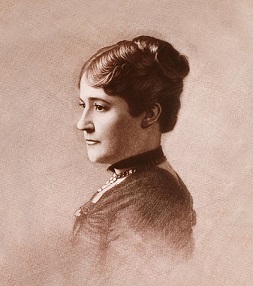Mary Arthur McElroy (1841 – 1917) [Section 19 Lot 5]
Sister of President Chester Arthur, surrogate First Lady during his administration, member of the Albany Association Against Women’s Suffrage

Mary “Molly” Arthur was born on July 5, 1841, in Greenwich, NY, the youngest of nine children to Rev. William Arthur and Melvina Stone. Due to the family’s strong abolitionist views, it required them to move frequently due to unpopularity. She was educated at Emma Willard School in Troy, N.Y., where she was prepping for a career as a school teacher. An article in The Washington Post suggested that Mary taught at a private school in Edgecombe County, North Carolina.
On June 13, 1861, she married John E. McElroy of Albany, a businessman and associate of Albany Insurance Company, who later served as president. Together they had four children and resided in Albany 27 Clinton Avenue, 14 State Street, and later 170 State Street.
Following to the death of her sister-in-law Ellen Arthur, (wife of Chester Arthur) in 1880, Mary helped care for her brother’s children. That same year James Garfield selected Chester to be his Republican running mate as vice-president, winning the election that November.
With the death of President Garfield in 1881, Arthur assumed duties becoming the 21st President. As a widower, he never remarried, and in her honor, donated a stained glass window to St. John’s Episcopal Church, which was kept lit at night so he could see it from the private quarters of the White House. His administration lacked the First Lady, and early in his administration, President Arthur handled first lady duties such as the social calendar and re-furnishing, redecorating, and added modern amenities to the White House. Due to the continuous visitors to President Garfield’s illness, the place needed an update, and Arthur was known for his stylish lifestyle.
Mary’s close relationship with his youngest daughter, Nellie, was a determining factor in selecting her to serve in the capacity as surrogate First Lady. Arthur never officially granted her the protocol of a formal position, and never had the official title. While in Washington, Mary’s role was more of a hostess and social planner of the Arthur administration. As Mary had a family of her own in Albany, she resided in the White House a portion of the year during the busy season.
On January 24, 1883, Mary started to serve in this capacity alongside her brother and began hosting receptions every Saturday. During her time in the White House, she introduced the custom of serving tea and refreshments after every reception. Unlike previous administrations, Mary’s hospitality during receptions made her “formal receptions less stilted and established a personal relationship with her guests.” Her “excellent reputation for hospitality” was acknowledged by her brother, who hosted a going-away party in her honor before venturing back to Albany every season.
Mary was strategic to add a more personal and lively touch to her events. She enlisted several women to help with White House functions. Some of these include her eldest daughter, May McElroy; her niece, and daughter of the president, Nellie Arthur; her sister, Malvina Haynesworth; and former first ladies Julia Tyler, the second wife of Whig James Tyler, and Harriet Lane, niece to Democrat James Buchanan. Harriet was familiar with throwing functions at the White House before the Civil War; her magnetic personality garnered her the nickname as the “Democratic Queen.” Mary’s final reception on February 28, 1885, as the Arthur administration was preparing to hand over the presidency, 48 daughters of officials and social elite assisted her for a party of over 3,000 guests.
When President Arthur passed away the following year in November in 1886, Mary and John became the legal guardians of Nellie. Additionally, Mary handled the funeral arrangements, serving in a role that is usually handled by the presidential widow.

Mary developed a relationship with the Cleveland administration. Before leaving Washington, she developed a friendship with Rose Elizabeth Cleveland, sister President-Elect Cleveland. Rose took over the roles and responsibilities as a surrogate First Lady until the marriage of her brother to Frances Clara Folsom in 1886. In 1889, Frances honored Mary as a guest of honor at the White House.
For the remainder of her life, Mary lived in Albany. In 1900 the McElroy’s hosted Booker T. Washington while on in the city for a speaking engagement. Though she raised with the beliefs for black equality by her abolitionist upbringing, she was vocally against the women’s suffrage movement. She was a member of the Albany Association Opposed to Women’s Suffrage.
Mary Arthur McElroy died on January 8, 1917, in Atlantic City, NJ, at the age of 76 years of Heart Disease. She is buried in the John E. McElroy family plot. Because she was the sister of the president without the recognition of title, Mary, is often, is omitted from biographies associated with First Ladies. Certain biographies of First Ladies list Ellen Arthur instead.